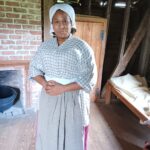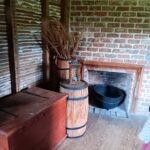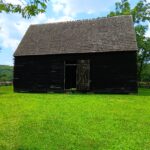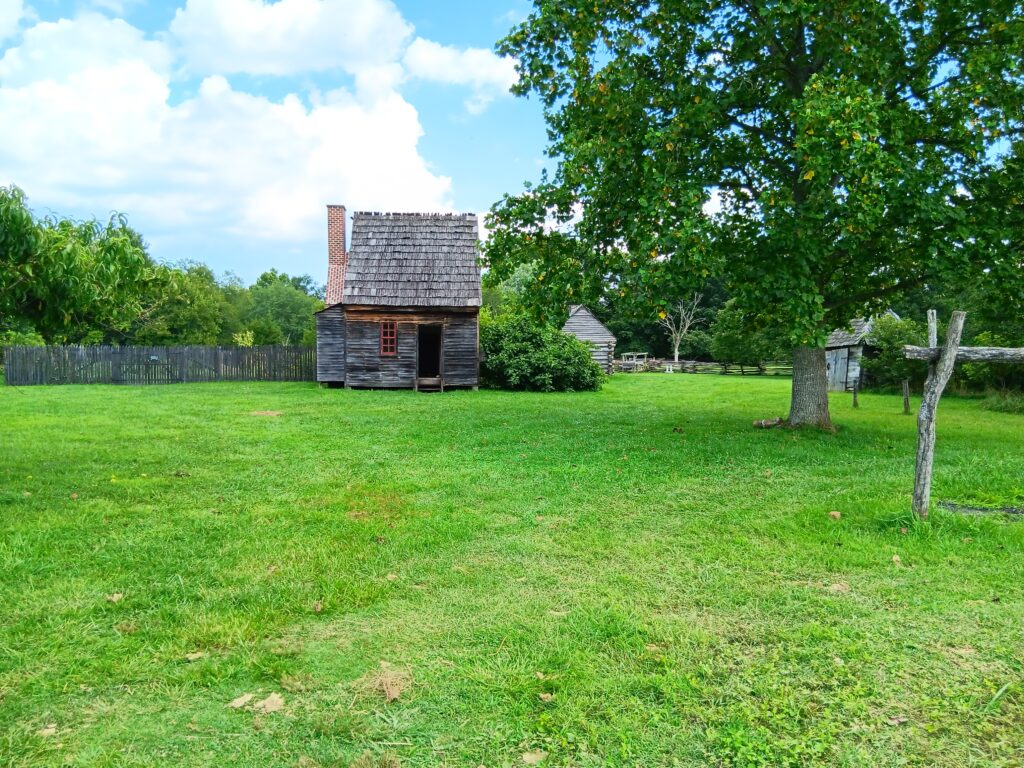 As an interpreter with the 7th Virginia Regiment, I enjoyed speaking to people about history. While most events were Revolutionary War battle re-enactments, some were educational, designed to share Colonial American life with the public. Often, I noticed that while they came for the battles and the sound of the rifles and cannons; they stayed and talked with us. Each event was different, and sometimes I didn’t know until arriving what subjects I may talk about that day. Most of the time, we chatted about the food. Who doesn’t like to eat? Sometimes, I talked about native plants and the many uses of the dandelion. Other folks were interested in our clothing and how it was made. And some wondered how we slept in that tent!
As an interpreter with the 7th Virginia Regiment, I enjoyed speaking to people about history. While most events were Revolutionary War battle re-enactments, some were educational, designed to share Colonial American life with the public. Often, I noticed that while they came for the battles and the sound of the rifles and cannons; they stayed and talked with us. Each event was different, and sometimes I didn’t know until arriving what subjects I may talk about that day. Most of the time, we chatted about the food. Who doesn’t like to eat? Sometimes, I talked about native plants and the many uses of the dandelion. Other folks were interested in our clothing and how it was made. And some wondered how we slept in that tent!
At times, representing the families that followed the soldiers from battle to battle, I thought about creating a persona, a role based on a real person, and speaking in first person. But it felt awkward, and none of the others in the organization were doing so. But I thought it would leave a more profound impression on people.
persona, a role based on a real person, and speaking in first person. But it felt awkward, and none of the others in the organization were doing so. But I thought it would leave a more profound impression on people.
I continued exploring my new backyard this week and went to the National Colonial Farm. This is a place I can see myself spending a lot of time. But for this trip, I had signed up for the Cate Sharper tour. As I was the only person signed up, the woman portraying Cate asked if I preferred a first or third-person portrayal. I decided on first person, and we set out. I couldn’t have made a better choice.
 We started at the pier gazing across the river at Mount Vernon, where I’ve encamped on the lawn. She talked about the Piscataway, the original people of the land here, and how the river served as their highway for travel and trade. Then we stepped inside the gate, and I met Cate.
We started at the pier gazing across the river at Mount Vernon, where I’ve encamped on the lawn. She talked about the Piscataway, the original people of the land here, and how the river served as their highway for travel and trade. Then we stepped inside the gate, and I met Cate.
Cate Sharper was an enslaved person who was taken from her mother when she was eight years old when the young mistress of the family married. Her primary task at her new home is to pick hornworms off the sticky tobacco leaves. She told me everything sticks to her hands and described how nasty the worms are. “There’s nothing worse than pulling hornworm,” Cate said. She described removing one, and it spewed the green leaves it was digesting onto her apron. We saw a few that day on the plants but left them alone.
Next, we went inside the master’s house where the ‘Bolton’ family lived. I learned later that the true family had asked their name not be used for fear of repercussion. Entering the house, Cate said, “Mind your step, now. Young Josiah recently took a tumble down them and hurt his leg.”
The home itself was a modest one which surprised me. While I know better, I sometimes think of slave owners as wealthier people in large houses. We stepped out the back door and viewed the kitchen, which is detached from the home. It was the original house before they built the new one. Cate showed me where she sleeps in the loft upstairs. She confided she is secretly married to a free black man named Tom and often slips out to  meet him at night. We wandered through the kitchen garden, looking at the herbs and vegetables that were growing there, most of which I recognized from my own talks.
meet him at night. We wandered through the kitchen garden, looking at the herbs and vegetables that were growing there, most of which I recognized from my own talks.
As we wandered toward the tobacco barn, Cate told me about her son, Jack. Because she is diminutive in stature, she is happy her boy has grown tall like her Tom. Jack could easily climb the rafters to help her hang the leaves out to dry. As we stood in the middle of the large barn, Cate said one day, she had overheard the master telling the mistress that there was no money left to buy seed. They would have to sell some property. And a few days later, Cate rolled over in her bed in the loft to find her son was gone. It was such an emotional and honest portrayal; I had tears in my eyes. I found myself clinging to her hope that her man would earn enough money to buy their boy and set him free.
As we walked, Cate invited me to “take a quick sketch” along the tour, including herself. When we walked back toward the Visitor’s Center, Cate stepped out of character, and we talked about her story. She explained about the family’s name and told me that parts of the story are factual, while others are compilations- drawn from the stories of others. Cate did have a son, but no records exist of what happened to him. But the story she told me in the barn is typical.
It was a very moving experience. When I return to Rev War re-enacting, I wonder if there is a way to incorporate the realism of a first-person narrative into my impression. I’ll have to give that some thought.
What is your preference?

Very enlightening, thank you for sharing your thoughts and Cate’s story. As always excellent photos.
For me third person is easier, less to remember.